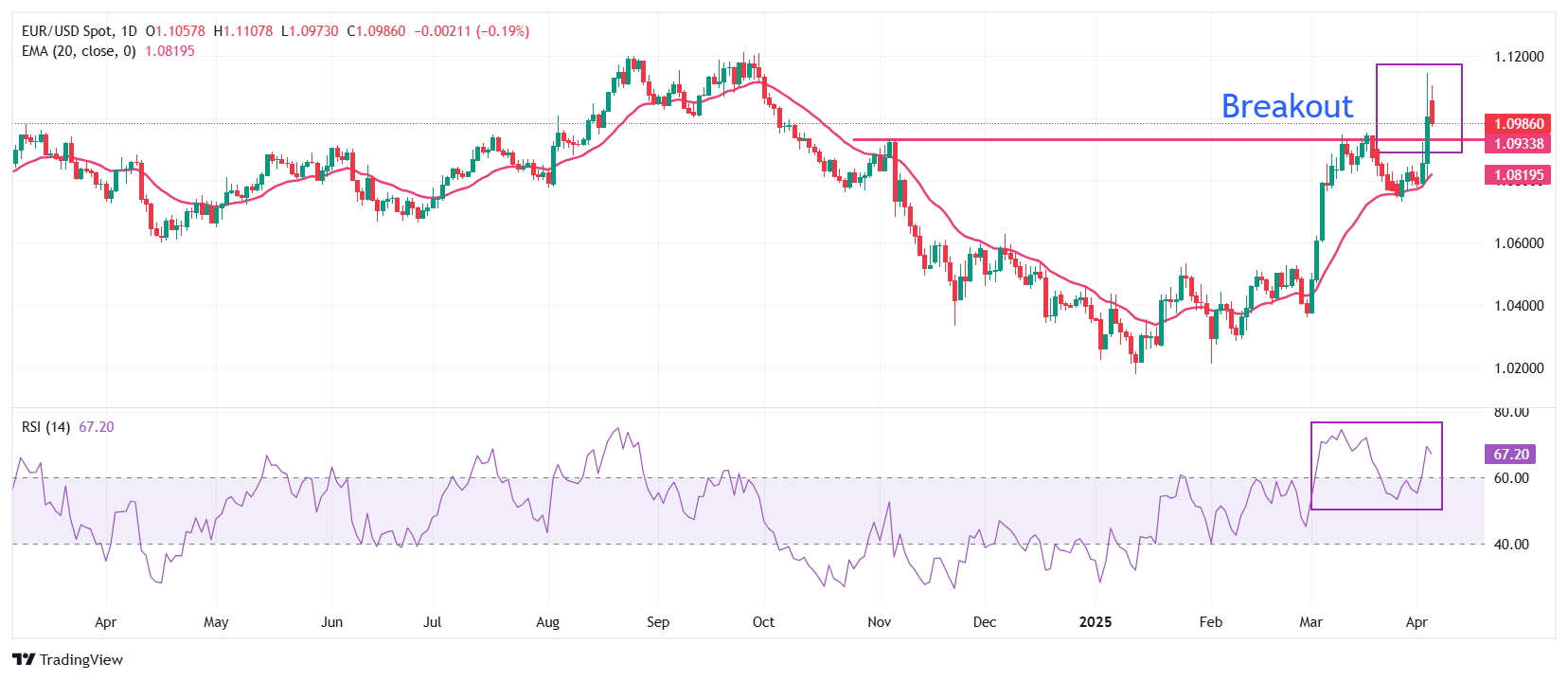- EUR/USD retraces to near 1.1030 as the US Dollar recovers ahead of the US NFP data for March and Fed Powell’s speech.
- The reciprocal tariffs by US President Trump have underpinned global economic risks.
- Investors expect the ECB to cut interest rates again in April.
EUR/USD corrects to near 1.1030 during European trading hours on Friday after posting a fresh six-month high at 1.1145 the previous day. The major currency pair retraces as the US Dollar (USD) rebounds after United States (US) President Donald Trump’s tariffs-driven sell-off and ahead of the Nonfarm Payrolls (NFP) data for March and Federal Reserve (Fed) Chair Jerome Powell’s speech due to in the North American session.
The US Dollar Index (DXY), which tracks the Greenback’s value against six major currencies, recovers above 102.00 from its six-month low of around 101.25.
Economists expect the US economy to have hired 135K fresh workers in March, lower than the 151K in February. The Unemployment Rate is expected to have remained steady at 4.1%. Average Hourly Earnings are estimated to have grown at a slower pace of 3.9% year-on-year compared to the 4% increase seen in February, with monthly figures rising steadily by 0.3%.
The impact of the employment data is expected to be limited on market expectations for the Fed’s monetary policy outlook unless there is a dramatic change in labor market figures, as investors are more concerned over potential inflation risks.
According to the CME FedWatch tool, traders have become increasingly confident that the central bank could cut interest rates in the June policy meeting after President Trump announced the reciprocal tariffs. The Fed’s probability of keeping interest rates in their current range of 4.25%-4.50% has also diminished to 65.8% from 81.5% recorded a week ago.
US Dollar PRICE Today
The table below shows the percentage change of US Dollar (USD) against listed major currencies today. US Dollar was the strongest against the Australian Dollar.
| USD | EUR | GBP | JPY | CAD | AUD | NZD | CHF | |
|---|---|---|---|---|---|---|---|---|
| USD | 0.32% | 0.81% | -0.58% | 0.50% | 3.12% | 2.42% | -0.96% | |
| EUR | -0.32% | 0.53% | -0.85% | 0.24% | 2.80% | 2.15% | -1.23% | |
| GBP | -0.81% | -0.53% | -1.38% | -0.30% | 2.29% | 1.61% | -1.77% | |
| JPY | 0.58% | 0.85% | 1.38% | 1.03% | 3.65% | 2.88% | -0.44% | |
| CAD | -0.50% | -0.24% | 0.30% | -1.03% | 2.55% | 1.87% | -1.47% | |
| AUD | -3.12% | -2.80% | -2.29% | -3.65% | -2.55% | -0.66% | -3.96% | |
| NZD | -2.42% | -2.15% | -1.61% | -2.88% | -1.87% | 0.66% | -3.31% | |
| CHF | 0.96% | 1.23% | 1.77% | 0.44% | 1.47% | 3.96% | 3.31% |
The heat map shows percentage changes of major currencies against each other. The base currency is picked from the left column, while the quote currency is picked from the top row. For example, if you pick the US Dollar from the left column and move along the horizontal line to the Japanese Yen, the percentage change displayed in the box will represent USD (base)/JPY (quote).
Daily digest market movers: EUR/USD declines as US Dollar gains temporary ground
- EUR/USD declines as the US Dollar recovers from its recent lows. However, the outlook of the USD remains uncertain as the imposition of harsh-than-expected reciprocal tariffs by Donald Trump has led to market experts becoming pessimists on global economic growth, including in the US.
- Market participants expect the implementation of full-scale tariffs will stoke inflation and weigh on US economic growth. Such a scenario will lead to stagflation in the economy, making the Federal Reserve’s job more complicated.
- On Wednesday, a 10% baseline levy on all imports into the US was announced, which will become effective on Saturday. Additionally, Trump slapped different tariffs for each country, ranging from 10% to 49%.
- To get fresh cues on Trump’s tariffs’ impact on the economy, investors will pay close attention to Fed Powell’s speech in which he is expected to hint about the likely monetary policy the central bank will maintain during the year.
- Meanwhile, the Euro (EUR) declines as investors expect Trump’s tariffs would weaken the Eurozone economic growth. Investors worry about a potential trade war between the Eurozone and the US over Trump’s sweeping reciprocal tariffs. European Commission (EC) President Ursula von der Leyen stated that the consequences will be “dire for millions of people around the globe”. Von der Leyen warned that the Eurozone is prepared to retaliate with countermeasures if negotiations with Washington fail.
- Additionally, firm expectations that the European Central Bank (ECB) will cut interest rates in April have also put some pressure on the Euro. ECB officials expect that Trump’s tariffs-driven inflation won’t be persistent in nature. Hence, it is not a major obstacle to further easing the monetary policy.
Technical Analysis: EUR/USD aims to hold 1.1000

EUR/USD gives up some of the prior day’s gains and declines to near 1.1030 during European trading hours on Friday. The major currency pair rallied to 1.1147 on Thursday after a decisive breakout above the prior resistance of 1.0955, which is March’s highest level. The near-term outlook of the major currency pair remains bullish as the 20-day Exponential Moving Average (EMA) resumes its upward journey, trading around 1.0820.
The 14-day Relative Strength Index (RSI) holds above 60.00, indicating an active bullish momentum.
Looking down, the prior resistance at 1.0955 and the March 31 high of 1.0850 will act as major support zones for the pair. Conversely, the September 25 high of 1.1214 will be the key barrier for the Euro bulls.
Economic Indicator
Nonfarm Payrolls
The Nonfarm Payrolls release presents the number of new jobs created in the US during the previous month in all non-agricultural businesses; it is released by the US Bureau of Labor Statistics (BLS). The monthly changes in payrolls can be extremely volatile. The number is also subject to strong reviews, which can also trigger volatility in the Forex board. Generally speaking, a high reading is seen as bullish for the US Dollar (USD), while a low reading is seen as bearish, although previous months’ reviews and the Unemployment Rate are as relevant as the headline figure. The market’s reaction, therefore, depends on how the market assesses all the data contained in the BLS report as a whole.
Read more.

